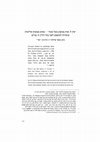Articles in Journals by Nitzan Caspi Shiloni

משפט וממשל כה, 2023
This paper is based on a critical narrative reading of Israeli rabbinic court rulings issued betw... more This paper is based on a critical narrative reading of Israeli rabbinic court rulings issued between the years 2015-2022, and which deal with constructing grounds for divorce based on physical violence perpetrated by a spouse. The study investigates fundamental gendered assumptions and values that underlie the basis of the rulings, as well as the manner in which gender is established in legal-halakhic texts. In practice, this work exists as a mirror image to complement the writings of scholars of Jewish Law that focus on grounds for divorce through a halakhic positivist analysis. This study proposes a distinction between the
rabbinic judges’ explicit position as expressed in their rulings (for instance, statements condemning violence from a moral standpoint) and the implicit narrative hidden between the lines. It also assumes the dissolution of the dichotomy between the factual component and the normative component of the legal text and focuses on interpreting the meaning that arises from the literary and rhetorical choices made by the rabbinic judges to describe the facts of a case in a certain manner.











Uploads
Articles in Journals by Nitzan Caspi Shiloni
rabbinic judges’ explicit position as expressed in their rulings (for instance, statements condemning violence from a moral standpoint) and the implicit narrative hidden between the lines. It also assumes the dissolution of the dichotomy between the factual component and the normative component of the legal text and focuses on interpreting the meaning that arises from the literary and rhetorical choices made by the rabbinic judges to describe the facts of a case in a certain manner.
rabbinic judges’ explicit position as expressed in their rulings (for instance, statements condemning violence from a moral standpoint) and the implicit narrative hidden between the lines. It also assumes the dissolution of the dichotomy between the factual component and the normative component of the legal text and focuses on interpreting the meaning that arises from the literary and rhetorical choices made by the rabbinic judges to describe the facts of a case in a certain manner.